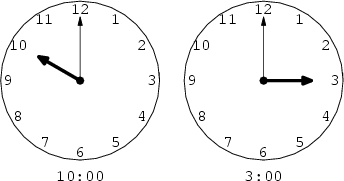If two numbers b and c have the property that their difference ![]() is integrally divisible by a number m (i.e.,
is integrally divisible by a number m (i.e., ![]() is an integer), then b and c are said to be "congruent modulo m." The number m is called the modulus, and the statement "b is congruent to c (modulo m)" is written mathematically as
is an integer), then b and c are said to be "congruent modulo m." The number m is called the modulus, and the statement "b is congruent to c (modulo m)" is written mathematically as
| (1) |
If ![]() is not integrally divisible by m, then we say "b is not congruent to c (modulo m)," which is written
is not integrally divisible by m, then we say "b is not congruent to c (modulo m)," which is written
| (2) |
The explicit "(mod m)" is sometimes omitted when the modulus m is understood by context, so in such cases, care must be taken not to confuse the symbol ![]() with the equivalence sign.
with the equivalence sign.
The quantity b is sometimes called the "base," and the quantity c is called the residue or remainder. There are several types of residues. The common residue defined to be nonnegative and smaller than m, while the minimal residue is c or ![]() ,
,

Congruence arithmetic is perhaps most familiar as a generalization of the arithmetic of the clock. Since there are 60 minutes in an hour, "minute arithmetic" uses a modulus of m = 60. If one starts at 40 minutes past the hour and then waits another 35 minutes, ![]() ,
,

Similarly, "hour arithmetic" on a 12-hour clock uses a modulus of m = 12, so 10 o'clock (a.m.) plus five hours gives ![]() ,
,
Congruences satisfy a number of important properties, and are extremely useful in many areas of number theory. Using congruences, simple divisibility tests to check whether a given number is divisible by another number can sometimes be derived. For example, if the sum of a number's digits is divisible by 3 (9), then the original number is divisible by 3 (9).
Congruences also have their limitations. For example, if ![]() and
and ![]() ,
,![]() ,
,![]() or
or ![]() .
.
Let ![]() and
and ![]() ,
,![]() means "implies":
means "implies":
- 1. Equivalence:
 (which can be regarded as a definition).
(which can be regarded as a definition).
- 2. Determination: either
 or
or  .
. - 3. Reflexivity:
 .
. - 4. Symmetry:
 .
. - 5. Transitivity:
 and
and  .
. - 6.
 .
. - 7.
 .
. - 8.
 .
. - 9.
 .
. - 10.
 .
. - 11.
 and
and  ,
, is the least common multiple.
is the least common multiple.
- 12.
 ,
, - 13. If
 ,
, ,
,
Properties (6-8) can be proved simply by defining
| (3) | |||
| (4) |
where r and s are integers. Then
| (5) | |||
| (6) | |||
| (7) |
so the properties are true.
Congruences also apply to fractions. For example, note that
| (8) |
so
| (9) |
To find ![]() (mod m) where
(mod m) where ![]() (i.e., q and m are relatively prime), use an algorithm similar to the greedy algorithm. Let
(i.e., q and m are relatively prime), use an algorithm similar to the greedy algorithm. Let ![]() and find
and find
| (10) |
where ![]() is the ceiling function, then compute
is the ceiling function, then compute
| (11) |
Iterate until ![]() ,
,
 |
(12) |
This method always works for m prime, and sometimes even for m composite. However, for a composite m, the method can fail by reaching 0 (Conway and Guy 1996).
Finding a fractional congruence is equivalent to solving a corresponding linear congruence equation
| (13) |
A fractional congruence of a unit fraction is known as a modular inverse. A fractional congruence can be found in Mathematica using the following function:
MyMod[r_Rational, m_Integer] := Mod[
Numerator[r]PowerMod[Denominator[r], -1, m], m]
MyMod[i_, m_] := Mod[i, m]
or using the undocumented syntax PolynomialMod[r, m].
![]()
Algebraic Congruence, Cancellation Law, Chinese Remainder Theorem, Common Residue, Congruence Axioms, Congruence Equation, Congruent, Divisibility Tests, Floor Function, Fractional Part, Functional Congruence, Geometric Congruence, Greatest Common Divisor, Integer Division, Least Common Multiple, Linear Congruence Equation, Minimal Residue, Mod, Modular Inverse, Modulus, Nearest Integer Function, Quadratic Congruence Equation, Quadratic Reciprocity Law, Quotient, Residue, RSA Encryption
![]()
![]()
Burton, D. M. "The Theory of Congruences." Ch. 4 in Elementary Number Theory, 4th ed. Boston, MA: Allyn and Bacon, pp. 80-105, 1989.
Conway, J. H. and Guy, R. K. "Arithmetic Modulo p." In The Book of Numbers. New York: Springer-Verlag, pp. 130-132, 1996.
Courant, R. and Robbins, H. "Congruences." §2 in Supplement to Ch. 1 in What Is Mathematics?: An Elementary Approach to Ideas and Methods, 2nd ed. Oxford, England: Oxford University Press, pp. 31-40, 1996.
Hardy, G. H. and Wright, E. M. "Congruences and Classes of Residues," "Elementary Properties of Congruences," "Linear Congruences," "General Properties of Congruences," and "Congruences to Composite Moduli." §5.2-5.4 and Chs. 7-8 in An Introduction to the Theory of Numbers, 5th ed. Oxford, England: Clarendon Press, pp. 49-52 and 82-106, 1979.
Hilton, P.; Holton, D.; and Pedersen, J. "A Far Nicer Arithmetic." Ch. 2 in Mathematical Reflections in a Room with Many Mirrors. New York: Springer-Verlag, pp. 25-60, 1997.
Jones, G. A. and Jones, J. M. "Congruences." Ch. 3 in Elementary Number Theory. Berlin: Springer-Verlag, pp. 37-63, 1998.
Nagell, T. "Theory of Congruences." Ch. 3 in Introduction to Number Theory. New York: Wiley, pp. 68-131, 1951.
Séroul, R. "Congruences." §2.5 in Programming for Mathematicians. Berlin: Springer-Verlag, pp. 11-12, 2000.
Shanks, D. Solved and Unsolved Problems in Number Theory, 4th ed. New York: Chelsea, p. 55, 1993.